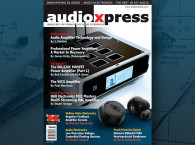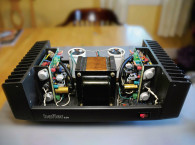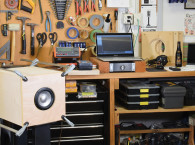 As tradition mandates, August is Acoustics Focus month for audioXpress. Since we refreshed audioXpress' contents in 2013, we have made acoustics an integral part of our mission, together with every other critical discipline in audio development and product design. This edition addresses the latest solutions, illustrated in the Acoustical Solutions Round-Up 2021 feature. Apart from the usual highlights of new cutting-edge acoustics products and solutions, the article addresses the need for products and designs that appeal to consumers and end-users, given our increasing personal connection with spaces, private and public, work or leisure. And for this 2021 update, we address another critical variable, which is the need for cleaning and disinfection of acoustic treatments, as well as surfaces featuring antimicrobial treatments. And because of its importance acoustics, this year's update also focuses on the latest measurement microphones and software tools.
As tradition mandates, August is Acoustics Focus month for audioXpress. Since we refreshed audioXpress' contents in 2013, we have made acoustics an integral part of our mission, together with every other critical discipline in audio development and product design. This edition addresses the latest solutions, illustrated in the Acoustical Solutions Round-Up 2021 feature. Apart from the usual highlights of new cutting-edge acoustics products and solutions, the article addresses the need for products and designs that appeal to consumers and end-users, given our increasing personal connection with spaces, private and public, work or leisure. And for this 2021 update, we address another critical variable, which is the need for cleaning and disinfection of acoustic treatments, as well as surfaces featuring antimicrobial treatments. And because of its importance acoustics, this year's update also focuses on the latest measurement microphones and software tools.The acoustics focus continues with a DIY perspective, first with Thomas Perazella detailing his personal journey on designing and configuring the treatments in his new listening room. In "Taming the Gorilla," Perazella addresses the "800-pound gorilla," which is the room itself and what needs to be considered for good sound reproduction in a home environment.
Next up, Ethan Winer, writes "An Introduction to Measuring Rooms," which was a topic he was inspired to address after reading a comment in our magazine about the need to "know your room." His article, written from a very practical perspective that can be attempted by everyone, explains the importance of understanding the acoustics of our own listening rooms and how a proper measurement will help us with that essential knowledge.
In his regular Sound Control column for audioXpress, Richard Honeycutt writes an interesting piece titled "Zooming Toward Better Online Audio." Like all of us, in the past year and a half, he was deeply committed to teleconferencing and using the available Zoom, Skype, and other online conferencing platforms. In this article, he addresses the acoustic conditions for those online meetings as well as real in-person meeting rooms, from his acoustician's perspective.

And this edition of audioXpress also features the definitive review of Audio Precision's APx517B Acoustic Analyzer. The Beaverton, OR-based audio test-and-measurement specialist placed a strong emphasis on this new solution, which debuted at the end of 2020. Primarily targeted at production test applications, the APx517B supplements AP's powerful product line of analyzers, which are considered the gold standard in audio measurement. In his review, David Logvin explores multiple audio measurements with this fully integrated hardware.
Another great article in this edition is "Parameter Estimation and Box Simulation with Speakerbench," written by Claus Futtrup and Jeff Candy. The two authors investigate leakage loss as identified with an advanced transducer model and verified with measurements. This is compared to classical Thiele-Small modeling with the intention to motivate the reader to further explore advanced parameter estimation and box simulation with the Speakerbench Speaker Design Calculations online tool. It is a great two-part article series that will conclude in the September edition of audioXpress - the Speaker Focus issue.
And this edition will certainly be appreciated by all the readers interested in audio electronics and DIY, as we conclude two very interesting articles from experts in the field. The first article is the final part of the DH-220C MOSFET Power Amplifier article by Bob Cordell and Rick Savas. Now detailing the construction and testing, this reference DIY project describes an upgrade construction project for the legendary Hafler DH-220 lateral MOSFET power amplifier, but it can also be used to upgrade other Hafler models or even inspire new designs.
In "A New Type of Amplifier for Direct Driving Loudspeakers," author Paul Marchese concludes his journey exploring an intriguing concept of an amplifier that behaves as a voltage source (VS) at low frequencies, then acts as a current source (CS) at higher frequencies. In the second and final part of the VSCS amplifier project, the author explores a practical feedback network on the voltage feedback side and examines the power delivered to a fairly accurate loudspeaker load and the non-ideal effects of a real-world power amplifier as well as variations of the design. A project for which audioXpress welcomes contributions from readers interested in building and evaluating its merits in actual loudspeakers. Speaker builders welcome!
 With this August 2021 edition focused on Acoustics to the next edition focused on Speakers, audioXpress continues to lead the way as the leading publication for the audio development and DIY communities. audioXpress is published 12 times per year, and available in print and online. Subscribing to the digital online version allows immediate access and is available here: www.audioxpress.com/page/audioXpress-Subscription-Services.html
With this August 2021 edition focused on Acoustics to the next edition focused on Speakers, audioXpress continues to lead the way as the leading publication for the audio development and DIY communities. audioXpress is published 12 times per year, and available in print and online. Subscribing to the digital online version allows immediate access and is available here: www.audioxpress.com/page/audioXpress-Subscription-Services.htmlIf you wish to buy a single printed issue or the complete audioXpress archive on USB, from 2000 to 2021 (yes, including the latest issue), just visit our online shop at www.cc-webshop.com
Don't miss out, get your copy of audioXpress right now at www.gotomyxpress.com






